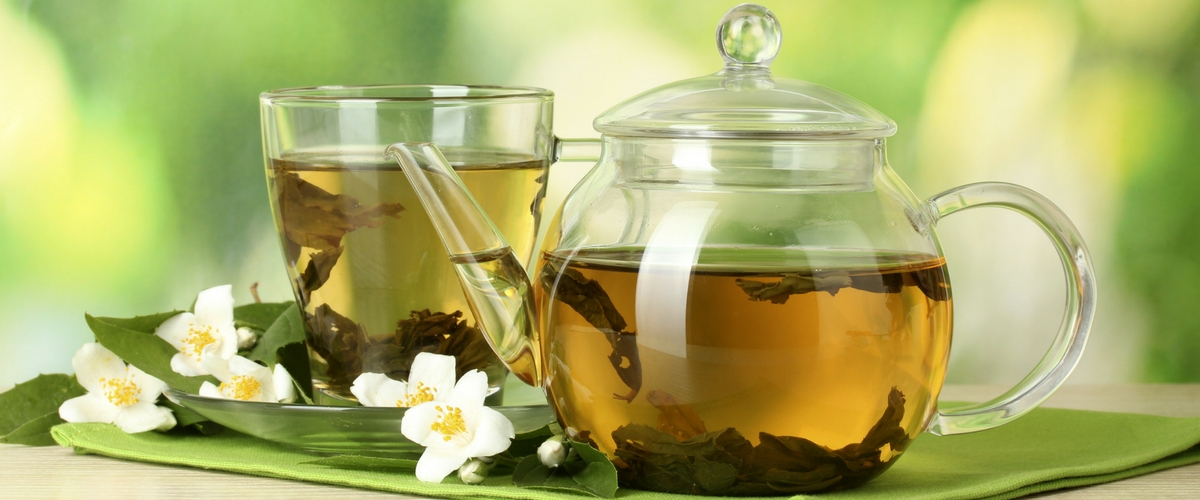Many tea bag drinkers prefer flavored to plain teas, generally herbal and/or Earl Grey. It can be hard for them to let go of the expectation of a big fruity or flowery upfront jolt and let a more subtle flavor unfold. Jasmine-infused tea is a really good choice here. It’s at one end of a spectrum from the bold and fruity citrus bergamot flavor of Earl Grey to the soft scented aromatic infusions of jasmine, rose and osmanthus petals at the other end.

It’s well worth your trying them out, especially jasmine pearls.
Jasmine Pearls look unusual: small balls of contrasting green leaf and white jasmine, almost woven together. They are infused with the scent of fresh petals added to the leaf, simply by placing them next to it during the drying process. These are truly fresh and not an essence or a dried blossom. It takes around four hours for the tea to absorb the jasmine scent, after which the petals are removed.
The process is repeated 2-3 times for ordinary grades and up to 10 for the best grades. The scented leaves are then rolled. The sequence may take a month; then the leaves are re-fired to remove any moisture, and the blossoms may be removed or left in the tea. The leaf is formed into small balls that are visually striking. When the tea is brewed, just a few dozen pearls will expand to half a cup, unfolding their locked in flavors. It’s something to have on hand because it is a great “mood” tea that every so often is just what you feel like in the afternoon, and it is one of the few teas that adds to light food.

Jasmine teas will appeal to anyone who likes sweet and mellow flavors. In particular, they are a green tea for people who don’t like green tea. They lack all the negatives they complain about: bitterness, blandness, vegetal/grassy/fishy/watery flavors, and the most damning of all epithets for tea: boring.
There is a wide range of these scented teas: Jasmine Pearls, Silver Needle white, Jade oolong, and Jasmine green. Indian Nilgiri and Darjeeling producers are using jasmine in their green teas in their search to enhance fine leaf rather than add taste to a so-so base. This is very different from many other scented teas, most especially Earl Grey, where the flower or fruit flavor is very strong.
Jasmine Green shows that a green tea need not be bitter, bland or flat. Jasmine Oolong is a little fuller and Jasmine Pearls are, well, ineffable, sublime and ambrosial – more picturesque ways of saying “really, really neat.” Jasmine has mainly been used to add a delicate scent to outstanding Chinese green and white teas, but it is increasingly being added to the blenders’ palette for oolongs, white teas and a few black teas in the style of an Earl Grey. The best stand out for their aftertaste, almost a perfume.
A caution here, though; however subtle it may be, it is perfumed and the jasmine can be a little too obstructive in the foreground of the taste. Many tea lovers report that they view it as an occasional rather than regular drink and that, perhaps like chocolate, you can have too much of a good thing.
This complex process invites shortcuts. Single- and double-petals offer a subtler scenting than multi-petal ones. Other factors that affect quality are the bud-petal ratio, how many times the jasmine and leaf are lightly baked so smooth the infusion. And, of course, the tea leaf itself. Some low price jasmine greens, the most popular variety, are undistinguished.
Overall, though, a well-made whole leaf jasmine tea is a special pleasure. Pick a tea you love – white, green, oolong, Fujian, Darjeeling, Earl Grey, Mao Feng, or Silver Needle. See if there’s a jasmine prefix for one of offer by your favorite provider. Try it. You’ll probably add it to your special stock. When a friend who hates green teas, bring out the jasmine pearls.


Comments are closed.